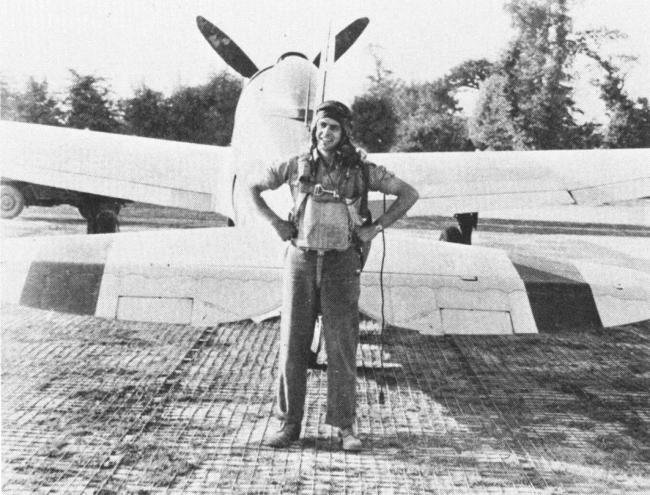90-year-old Hank Bakken has led a remarkable life
Lt. Hank Bakken behind his P-47 Thunderbolt CLICK ON THE PHOTO TO PLAY SLIDESHOW.
Tue, 10/05/2010
This month Hank Bakken turns 90. Though he no longer builds remarkable houses, this modest Burien man has lived a remarkable life.
I luckily met him 30 years ago after I asked the owners of Logan Lumber (now Dunn Lumber) if they knew a good builder. I asked a bunch of their employees.
Everybody sang his praises.
Thirty years later the house Hank built has never had a crack in the plaster. Burien Architect Al Sasonoff designed it strong and Hank built it the same way. They made a great team.
Maybe it was the mud and dirt of Auburn High's football turf in the late 30's that gave Hank the grit he needed to become an all-star athlete in two sports. Maybe it was his mom and pop who instilled in him the traits that carried him through WWII and a 62-year marriage.
Whatever he learned as a youth was put to the test after Pearl Harbor. Hank enlisted with the Army Air Corp in 1942 just days before he got his draft notice.
Skinny and smart, Hank signed up for flight training in Uvalde, Texas, just west of San Antonio. His bunkmate from Illinois was Dick Barnes, later to become a Washington State Representative from Normandy Park.
Together they learned how to fly. After nine weeks Hank was selected to take fighter training in Tallahassee Florida learning to fly P47 Thunderbolts. This single engine Republic aircraft was an upgrade from the clunkier twin engine P38's the Army Air Corp had been flying. It was decided by the Army brass that they needed an airplane to compete with the German Messerschmitt 109's.
Hank got a short trip home after P47 training before ending up in New York waiting for a troop ship convoy headed to Liverpool.
Much of England was under constant fear from German V1 rockets by 1944. They were sometimes called a Buzz Bomb or Doodlebug by the British. Hank got a lesson in flying skills from the British pilots. Using Spitfires or Hawker Tempest aircraft, these "Diver Pilots" would swoop down on a V1 from above.
With their increased acceleration they could intercept the flying bomb. Then gently flying wing tip to wing tip they would nudge the V1. This dangerous action upset the gyro guidance system forcing the V1 to crash harmlessly on land or into the English Channel.
As a P47 Thunderbird pilot part of Hank's job was seeking out targets in German-occupied France. A natural target was any freight train. On one flight he spotted some tracks leading into a forest. Hank was a savvy Northwestern kid having spent time in the woodsy areas around Auburn. A skill kids from Nebraska might not possess was the ability to see the forest through the trees. In this case the boxcar was an obvious target.
Hank dropped his P47 very low over the tree tops sending a barrage of 50 caliber bullets into the vaguely lit boxcar.
The resulting explosion (later determined to be a German ammo supply) created a tremendous concussion sending his plane skyward more than 2000 ft. Communications were lost momentarily with many thinking Hank was toast. As the plume faded the trailing pilot noticed Hank ascending into a turn for base. All was well.
The P47 was not as fast at 350 mph as the German Messerschmitt. Hank was instructed to never "run" from an engagement, as the German's would certainly catch him with their superior speed. Better if he turned and faced them head-on. Hank learned quicker than some unlucky pilots. This maneuver proved very effective and helped keep him flying, earning the Distinguished Flying Medal for valor in the air.
By 1947 the Army Air Corp became the Air Force. Hank got his fancy dress blues mustering out a short time later that year.
Back in the area he returned to his youthful trade as a carpenter's apprentice. Saturday nights were made for roller skating in Hank's mind. He'd found his way to the rink in Renton where he spotted his future wife who later admitted she set her eyes on Hank first but played hard to get.
Fighter pilots returning from battle are not dismayed by the indifference of a young girl. He convinced her to twirl the rink without a blink. He knew an angel when he saw one. He'd spent enough years flying up where they live.
She was a Whidbey Island beauty named Jean Hagstrom and a year later she became his bride. They have three children, two daughters and a son.
Hank risked his neck for three years as a fighter pilot and never got a scratch but after he became a contractor he was building a two-story house and was walking across the rafters on the top floor while looking at the sky (maybe for enemy planes) when he stepped backward and crash landed like a sack of bran on the floor below.
Shook up but uninjured he luckily landed on some loose chunks of plywood with only a thud and was on the job the next day.
While that was many years ago Hank maintains the physique of a younger man. His steel blue eyes are as keen as the day he took flight training. At 90 he deserves to have his story told. I hope I've helped.





